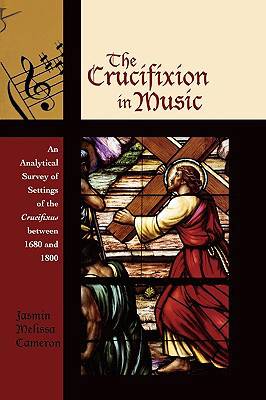
- Afhalen na 1 uur in een winkel met voorraad
- Gratis thuislevering in België vanaf € 30
- Ruim aanbod met 7 miljoen producten
- Afhalen na 1 uur in een winkel met voorraad
- Gratis thuislevering in België vanaf € 30
- Ruim aanbod met 7 miljoen producten
Zoeken
The Crucifixion in Music
An Analytical Survey of Settings of the Crucifixus Between 1680 and 1800
Jasmin Melissa Cameron
€ 143,45
+ 286 punten
Uitvoering
Omschrijving
Unique yet diverse in its approach, The Crucifixion in Music examines how text is set in music through the specific musicological period from 1680 to 1800. The treatise focuses specifically on the literary text of the Crucifixus from the Credo of the Ordinary of the Roman Catholic Mass. Combining analytical theory and method to address musical rhetoric, semiotics, and theory, author Jasmin Cameron follows the Crucifixion through many settings in Baroque and Classical music.
In this first title in Scarecrow Press's new series, Contextual Bach Studies, Cameron studies musical representations of the text, first through a discussion that establishes a theoretical framework, then by applying the framework to individual case studies, such as Johann Sebastian Bach's B Minor Mass. By studying the musical representation of the text, and the concepts and contexts to which the words refer, Cameron examines the way the treatment of a literary text fuses into a recognizable musical tradition that composers can follow, develop, modify, or ignore. With equal time given to the settings of the Crucifixus by composers before and after Bach's time, the reader is provided with a fuller historical context for Bach's genius. Cameron also combines the beliefs of past theorists with those of today, reaching a common ground among them, and providing a basis and analytical framework for further study.Specificaties
Betrokkenen
- Auteur(s):
- Uitgeverij:
Inhoud
- Aantal bladzijden:
- 396
- Taal:
- Engels
- Reeks:
- Reeksnummer:
- nr. 1
Eigenschappen
- Productcode (EAN):
- 9780810858725
- Verschijningsdatum:
- 1/08/2006
- Uitvoering:
- Paperback
- Formaat:
- Trade paperback (VS)
- Afmetingen:
- 155 mm x 230 mm
- Gewicht:
- 635 g

Alleen bij Standaard Boekhandel
+ 286 punten op je klantenkaart van Standaard Boekhandel
Beoordelingen
We publiceren alleen reviews die voldoen aan de voorwaarden voor reviews. Bekijk onze voorwaarden voor reviews.











